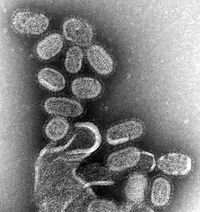
Photo from wikipedia
Abstract Background Post-exposure antiviral chemoprophylaxis with neuraminidase inhibitors (NI) is 80% effective in preventing influenza in household members. In hospital settings, management of exposed roommates has not been specifically addressed… Click to show full abstract
Abstract Background Post-exposure antiviral chemoprophylaxis with neuraminidase inhibitors (NI) is 80% effective in preventing influenza in household members. In hospital settings, management of exposed roommates has not been specifically addressed in clinical studies. Some experts recommend immunocompromised individuals exposed to influenza to receive therapeutic doses of NI as a preventive measure regardless of duration of exposure. The objective of this study was to determine optimal intervention in high-risk patients exposed to influenza based on duration of spatial overlap and viral testing at the time exposure is recognized. Methods MSK is a 473-bed tertiary care cancer center. Infection Control performs contact investigation for cases diagnosed with influenza including baseline testing of exposed roommates using a multiplex PCR test. The primary team is notified of exposures and makes recommendations regarding prophylaxis. Retrospective review of patients considered exposed to influenza during three seasons was performed. Information on spatial overlap, prophylaxis, and viral testing was extracted. Results Out of 64 patients exposed, five (8%) developed influenza (table). Baseline testing was done in 51 (80%): none with overlap of <4 days were symptomatic or tested positive; 2/12 with overlap >4 days tested positive. Attack rate for those with exposure time <4 days who did not receive prophylaxis was 2.6%. No breakthrough infection occurred in the prophylaxis group. Post exposure follow-up revealed two more cases for those overlapping >4 days; a single case of breakthrough infection developed at 7 days, resistance testing was not performed, and patient responded to therapeutic doses of NI without persistent shedding. Conclusion Duration of overlap in semi-private rooms correlates with secondary cases of influenza. Prophylactic doses of NI are safe and effective for asymptomatic individuals with exposure <4 days to index case. For patients with spatial overlap >4 days, baseline testing is recommended to recognize cases early and interrupt nosocomial transmission. Overlap Duration, days Exposed Number Prophylaxis Administered Tested at Baseline Attack Rate % (Prophylaxis Group) Attack Rate % (No Prophylaxis Group) <2 34 9 (26%) 28 (82%) 0 4% (1) 2–4 18 5 (28%) 15 (83%) 0 0 >4 12 6 (50%) 8 (67%) 16% (1) 50% (3) Disclosures All authors: No reported disclosures.
Journal Title: Open Forum Infectious Diseases
Year Published: 2018
Link to full text (if available)
Share on Social Media: Sign Up to like & get
recommendations!